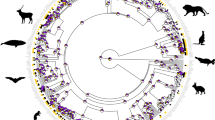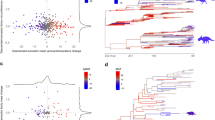Abstract
Phenotype-based selective harvests, including trophy hunting, can have important implications for sustainable wildlife management if they target heritable traits1,2,3. Here we show that in an evolutionary response to sport hunting of bighorn trophy rams (Ovis canadensis) body weight and horn size have declined significantly over time. We used quantitative genetic analyses, based on a partly genetically reconstructed pedigree from a 30-year study of a wild population in which trophy hunting targeted rams with rapidly growing horns4, to explore the evolutionary response to hunter selection on ram weight and horn size. Both traits were highly heritable, and trophy-harvested rams were of significantly higher genetic ‘breeding value’ for weight and horn size than rams that were not harvested. Rams of high breeding value were also shot at an early age, and thus did not achieve high reproductive success5. Declines in mean breeding values for weight and horn size therefore occurred in response to unrestricted trophy hunting, resulting in the production of smaller-horned, lighter rams, and fewer trophies.
This is a preview of subscription content, access via your institution
Access options
Subscribe to this journal
Receive 51 print issues and online access
$199.00 per year
only $3.90 per issue
Buy this article
- Purchase on Springer Link
- Instant access to full article PDF
Prices may be subject to local taxes which are calculated during checkout



Similar content being viewed by others
References
Thelen, T. H. Effects of harvest on antlers of simulated populations of elk. J. Wild. Mgmt 55, 243–249 (1991)
Harris, R. B., Wall, W. A. & Allendorf, F. W. Genetic consequences of hunting: what do we know and what should we do? Wildl. Soc. Bull. 30, 634–643 (2002)
Festa-Bianchet, M. in Animal Behavior and Wildlife Conservation (eds Apollonio, M. & Festa-Bianchet, M.) 191–207 (Island Press, Washington DC, 2003)
Festa-Bianchet, M., Coltman, D. W., Turelli, L. & Jorgenson, J. T. Relative allocation to horn and body growth in bighorn rams varies with resource availability. Behav. Ecol. (in the press)
Coltman, D. W., Festa-Bianchet, M., Jorgenson, J. T. & Strobeck, C. Age-dependent sexual selection in bighorn rams. Proc. R. Soc. Lond. B 269, 165–172 (2002)
Milner-Gulland, E. J. et al. Conservation—reproductive collapse in saiga antelope harems. Nature 422, 135 (2003)
Marty, S. Sacrificial ram. Can. Geographic November/December, 37–50 (2002)
Clutton-Brock, T. H., Coulson, T. N., Milner-Gulland, E. J., Thomson, D. & Armstrong, H. M. Sex differences in emigration and mortality affect optimal management of deer populations. Nature 415, 633–637 (2002)
Ginsberg, J. R. & Milner Gulland, E. J. Sex-biased harvesting and population dynamics in ungulates—implications for conservation and sustainable use. Conserv. Biol. 8, 157–166 (1994)
Langvatn, R. & Loison, A. Consequences of harvesting on age structure, sex ratio and population dynamics of red deer Cervus elaphus in central Norway. Wildl. Biol. 5, 213–223 (1999)
Laurian, C., Ouellet, J. P., Courtois, R., Breton, L. & St-Onge, S. Effects of intensive harvesting on moose reproduction. J. Appl. Ecol. 37, 515–531 (2000)
Ashley, M. V. et al. Evolutionarily enlightened management. Biol. Conserv. 111, 115–123 (2003)
Conover, D. O. & Munch, S. B. Sustaining fisheries yields over evolutionary time scales. Science 297, 94–96 (2002)
Palumbi, S. R. Evolution—humans as the world's greatest evolutionary force. Science 293, 1786–1790 (2001)
Law, R. Fishing, selection, and phenotypic evolution. Ices J. Mar. Sci. 57, 659–668 (2000)
Jachmann, H., Berry, P. S. M. & Imae, H. Tusklessness in African elephants—a future trend. Afr. J. Ecol. 33, 230–235 (1995)
Jorgenson, J. T., Festa-Bianchet, M. & Wishart, W. D. Effects of population density on horn development in bighorn rams. J. Wildl. Mgmt 62, 1011–1020 (1998)
Lynch, M. & Walsh, B. Genetics and Analysis of Quantitative Traits (Massachusetts, Sinauer, Sunderland, 1998)
Hogg, J. T. & Forbes, S. H. Mating in bighorn sheep: frequent male reproduction via a high-risk ‘unconventional’ tactic. Behav. Ecol. Sociobiol. 41, 33–48 (1997)
Hendry, A. P. & Kinnison, M. T. Perspective: The pace of modern life: measuring rates of contemporary microevolution. Evolution 53, 1637–1653 (1999)
Merilä, J., Kruuk, L. E. B. & Sheldon, B. C. Cryptic evolution in a wild bird population. Nature 412, 76–79 (2001)
Coltman, D. W., Pilkington, J., Kruuk, L. E. B., Wilson, K. & Pemberton, J. M. Positive genetic correlation between parasite resistance and body size in a free-living ungulate population. Evolution 55, 2116–2125 (2001)
Jorgenson, J. T., Festa-Bianchet, M. & Wishart, W. D. Harvesting bighorn ewes—consequences for population-size and trophy ram production. J. Wildl. Mgmt 57, 429–435 (1993)
Festa-Bianchet, M., Jorgenson, J. T., King, W. J., Smith, K. G. & Wishart, W. D. The development of sexual dimorphism: seasonal and lifetime mass changes in bighorn sheep. Can. J. Zool. 74, 330–342 (1996)
Crawford, A. M. et al. An autosomal genetic linkage map of the sheep genome. Genetics 140, 703–724 (1995)
Slate, J. et al. Bovine microsatellite loci are highly conserved in red deer (Cervus elaphus), sika deer (Cervus nippon) and Soay sheep (Ovis aries). Anim. Genet. 29, 307–315 (1998)
Marshall, T. C., Slate, J., Kruuk, L. E. B. & Pemberton, J. M. Statistical confidence for likelihood-based paternity inference in natural populations. Mol. Ecol. 7, 639–655 (1998)
Goodnight, K. F. & Queller, D. C. Computer software for performing likelihood tests of pedigree relationship using genetic markers. Mol. Ecol. 8, 1231–1234 (1999)
Groeneveld, E., Kovac, M., Wang, T. L. & Fernando, R. L. Computing algorithms in a general purpose BLUP package for multivariate prediction and estimation. Arch. Anim. Breed. 15, 399–412 (1992)
Groeneveld, E. User's Guide: REML VCE, a Multivariate Multi-Model Restricted Maximum Likelihood (Co)variance Estimation Package, Version 3.2 (Institute of Animal Husbandry and Animal Behaviour, Federal Research Center of Agriculture (FAL) (Mariensee, Germany, 1995)
Acknowledgements
We thank the many students, colleagues, volunteers and assistants that contributed to this research over the past 30 years. B. Wishart initiated the Ram Mountain project. Our research was funded by the Alberta Conservation Association, Alberta Fish and Wildlife Division, Alberta Recreation, Sports, Parks and Wildlife Foundation, Eppley Foundation for Research, Foundation for North American Wild Sheep, National Geographic Society, Natural Environment Research Council (UK), Natural Sciences and Engineering Research Council of Canada, Rocky Mountain Elk Foundation (Canada), and the Université de Sherbrooke. We are grateful for the logistical support of the Alberta Forest Service.
Author information
Authors and Affiliations
Corresponding author
Ethics declarations
Competing interests
The authors declare that they have no competing financial interests.
Rights and permissions
About this article
Cite this article
Coltman, D., O'Donoghue, P., Jorgenson, J. et al. Undesirable evolutionary consequences of trophy hunting. Nature 426, 655–658 (2003). https://doi.org/10.1038/nature02177
Received:
Accepted:
Issue Date:
DOI: https://doi.org/10.1038/nature02177
This article is cited by
-
Exploring genetic diversity and variation of Ovar-DRB1 gene in Sudan Desert Sheep using targeted next-generation sequencing
BMC Genomics (2024)
-
Range-wide and temporal genomic analyses reveal the consequences of near-extinction in Swedish moose
Communications Biology (2023)
-
Using density estimates, sex ratios and size structure to assess the status of a threatened Australian freshwater crayfish (Euastacus armatus) population
Hydrobiologia (2023)
-
Make flying-fox hunting sustainable again: Comparing expected demographic effectiveness and hunters’ acceptance of more restrictive regulations
Ambio (2022)
-
Using spot pattern recognition to examine population biology, evolutionary ecology, sociality, and movements of giraffes: a 70-year retrospective
Mammalian Biology (2022)
Comments
By submitting a comment you agree to abide by our Terms and Community Guidelines. If you find something abusive or that does not comply with our terms or guidelines please flag it as inappropriate.



